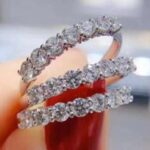Jade is a precious stone that has been prized for its beauty and cultural significance for centuries. Hetian jade, in particular, has a long history and is highly sought after for its unique qualities. However, identifying real Hetian jade can be a challenge, as it is often imitated by other materials. In this article, we will discuss the key characteristics to look for to determine if Hetian jade is real or fake.
Understanding Hetian Jade
Before we delve into the characteristics of real Hetian jade, it’s important to understand what it is and its cultural significance. Hetian jade is a type of jade that is found in the Hetian region of China, and it has been used in Chinese culture for over 7,000 years. It is often referred to as the “imperial jade” because it was once exclusively reserved for emperors.
There are two main types of Hetian jade: nephrite jade and jadeite jade. Nephrite jade is more common and is known for its toughness and resistance to breakage, while jadeite jade is more valuable and has a wider range of colors.
Characteristics of Real Hetian Jade
Real Hetian jade has a number of characteristics that set it apart from other materials. Here are the key characteristics to look for:
Appearance
The appearance of Hetian jade can vary depending on the type and quality, but there are some general characteristics to look for:
. Color: Real Hetian jade has a range of colors, including white, green, brown, and black. However, the colors should be natural and not artificially enhanced or dyed.
Is Hetian Jade White or Green?
- Texture: Hetian jade has a unique texture that is smooth and waxy to the touch. It should not have any rough spots or uneven areas.
- Transparency: Real Hetian jade is often translucent, which means that light can pass through it. However, it should not be completely transparent like glass.
Weight and Hardness
The weight and hardness of Hetian jade can also provide clues as to its authenticity:
- Specific gravity: Hetian jade has a specific gravity of around 3.0, which is higher than most other materials that may be used to imitate it.
- Hardness: Hetian jade is a relatively hard stone, with a hardness of 6.5 to 7 on the Mohs scale. It should not be easily scratched or damaged.
Sound
The sound that Hetian jade makes can also be a clue as to its authenticity:
- Sound test: When you tap Hetian jade with a metal object, it should make a clear, crisp sound.
- Chime test: Another way to test the sound of Hetian jade is to hold it close to your ear and gently tap it with another piece of jade. Real Hetian jade will produce a clear, melodious chime.
Conductivity
Finally, the conductivity of Hetian jade can also provide clues as to its authenticity:
- Heat conductivity: When you hold Hetian jade in your hand, it should feel cool to the touch. This is because it has a low heat conductivity.
- Electrical conductivity: Hetian jade is not conductive, which means it should not produce any electrical current when tested.
Differentiating Real and Fake Hetian Jade
While the above characteristics can help you identify real Hetian jade, there are also a number of materials that are often used to imitate it. According to wholesalecrystaljewellery.com experts said,Here are some of the most common imitations to be aware of:
Synthetic Jade
Synthetic jade is made from a combination of minerals and chemicals, and it is designed to mimic the look and feel of natural jade. However, synthetic jade does not have the same unique characteristics as natural Hetian jade.
Dyed Jade
Some sellers may try to enhance the color of jade by dyeing it. While dyeing jade is not necessarily bad, it can be used to hide imperfections or enhance the color in a way that is not natural.
Treated Jade
Treated jade is jade that has been treated with chemicals or other substances to enhance its appearance. However, these treatments can make it difficult to determine if the jade is real or fake.
Imposters
There are also a number of materials that may be used to imitate jade, including glass, plastic, and other stones. These materials may look similar to jade, but they do not have the same unique characteristics.
Conclusion
Identifying real Hetian jade can be a challenge, but by understanding its key characteristics and being aware of common imitations, you can make an informed decision when purchasing jade. Remember to always buy from a reputable seller, and if you’re unsure about the authenticity of a piece of jade, consider consulting with an expert. With these tips in mind, you can add a beautiful and valuable piece of Hetian jade to your collection with confidence.If you are looking for some high-quality gemstone jewelry, you can visit this website.


